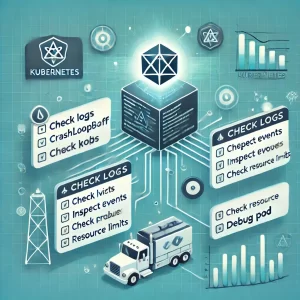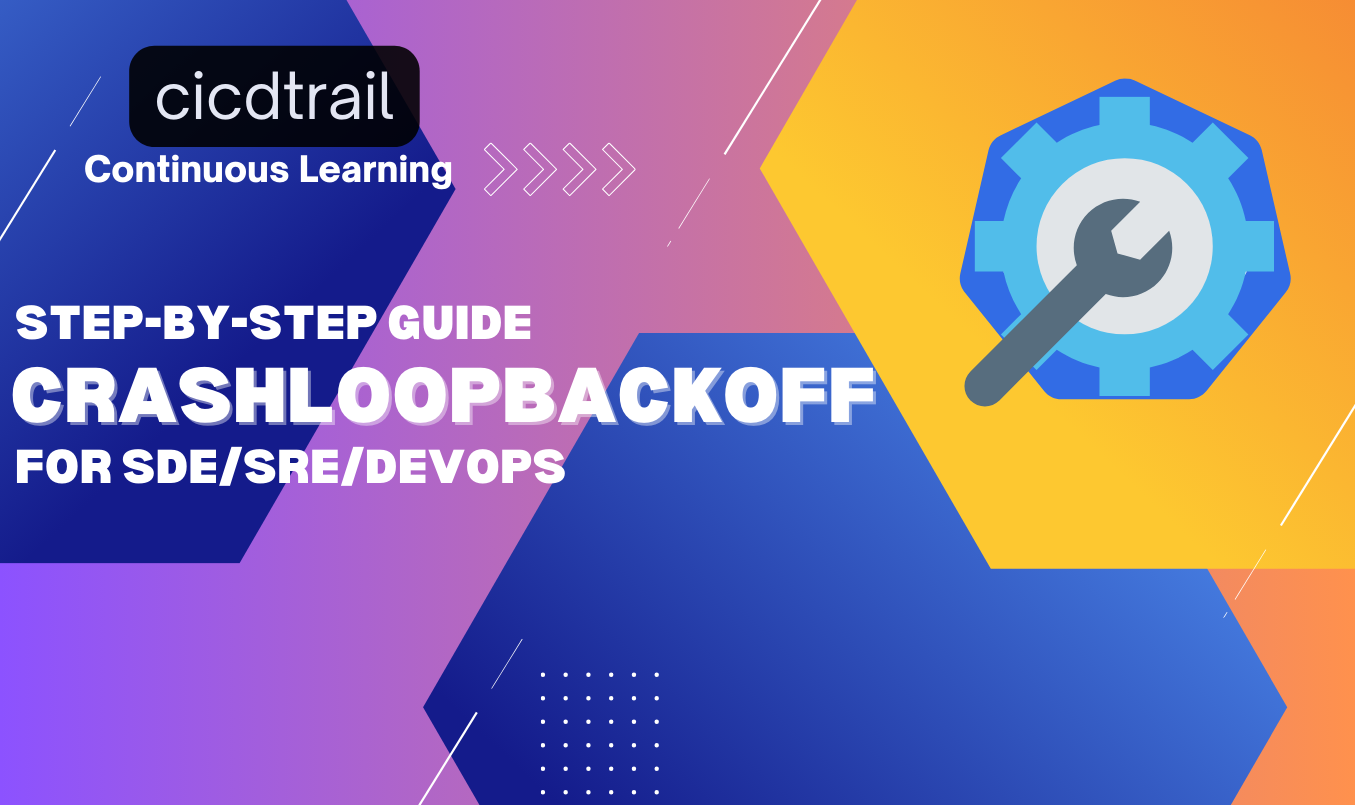How to Fix Kubernetes CrashLoopBackOff
A Step-by-Step Troubleshooting Guide
Kubernetes is a powerful container orchestration system, but when applications fail to start correctly, it can lead to frustrating errors like CrashLoopBackOff. This issue occurs when a container repeatedly crashes and Kubernetes attempts to restart it but eventually backs off due to multiple failures.
In this guide, we’ll break down the CrashLoopBackOff error, how to diagnose the root cause, and provide practical troubleshooting steps with some really useful Kubernetes commands.
🚨 What is CrashLoopBackOff in Kubernetes?
The CrashLoopBackOff error means that a pod is failing to start and Kubernetes is continuously trying to restart it, but due to repeated failures, it gradually increases the retry delay (hence, “backoff”).
🛑 Common Causes of CrashLoopBackOff
- Application crash due to bugs, misconfiguration, or dependency issues.
- Incorrect environment variables (e.g., missing required configs).
- Insufficient CPU/Memory resources causing the pod to be killed.
- Missing or misconfigured secrets/configMaps used by the pod.
- Failed liveness/readiness probes, causing Kubernetes to restart the pod.
- Issues with container images (e.g., incorrect tags, missing binaries).
- Network issues, preventing connections to required services.
🔍 How to Troubleshoot CrashLoopBackOff?
Before we start troubleshooting, this is structured approach I personally follow, especially when dealing with an intriguing issue like CrashLoopBackOff.
First, check the logs. Then, inspect events. Next, verify probes. Finally, debug the pod. With that said, Let’s dive in!
Step 1: Check Pod Status
Run the following command to get an overview of the problematic pod:
kubectl get pods -n <namespace>
Look for the STATUS column showing CrashLoopBackOff. Example output:
NAME READY STATUS RESTARTS AGE
my-app-6df89f8ddc-xyz 0/1 CrashLoopBackOff 5 10m
Step 2: Describe the Pod for More Details
kubectl describe pod my-app-6df89f8ddc-xyz -n <namespace>
This command provides logs related to scheduling, events, and restart reasons.
👉 Key areas to check:
- Events section: Look for warnings or failed probes.
- Container exit code: Helps identify why the container stopped.
- Resource constraints: Check if the pod is being OOMKilled (Out of Memory).
Example output:
State: Waiting
Reason: CrashLoopBackOff
Last State: Terminated
Exit Code: 1
Message: Application failed to start due to missing database connection.
Step 3: Check Pod Logs for CrashLoopBackOff Errors
kubectl logs my-app-6df89f8ddc-xyz -n <namespace>
👉 If the pod has multiple containers, use:
kubectl logs my-app-6df89f8ddc-xyz -n <namespace> -c <container-name>
Look for errors related to application start-up, misconfigurations, or missing dependencies.
Example log output:
Error: Failed to connect to database. Connection refused.
🚀 Fix: Ensure the database service is running and environment variables are correctly set.
Step 4: Check for Failed Liveness/Readiness Probes
If a pod keeps restarting due to failed health checks, inspect the probes:
kubectl describe pod my-app-6df89f8ddc-xyz -n <namespace> | grep -A5 "Liveness"
Example failed liveness probe log:
Liveness probe failed: HTTP probe failed with status code 500
🚀 Fix: Adjust the probe settings in the deployment YAML file or investigate why the application is not responding.
Step 5: Verify Resource Limits & Quotas
Pods can crash if they exceed allocated CPU/memory limits. Check for OOMKilled (Out of Memory Kills):
kubectl get pod my-app-6df89f8ddc-xyz -o jsonpath="{.status.containerStatuses[*].state.terminated.reason}"
If it returns OOMKilled, increase resource requests/limits in the deployment:
resources:
requests:
memory: "256Mi"
cpu: "250m"
limits:
memory: "512Mi"
cpu: "500m"
Apply changes:
kubectl apply -f deployment.yaml
Step 6: Check ConfigMaps & Secrets
If your pod depends on ConfigMaps or Secrets, verify they are correctly mounted:
kubectl get configmap -n <namespace>
kubectl get secret -n <namespace>
Check if the environment variables are correctly set:
kubectl exec -it my-app-6df89f8ddc-xyz -- env | grep MY_ENV_VAR
🚀 Fix: If a required variable is missing, update your deployment YAML to include it.
Step 7: Debug the Pod with an Interactive Shell
If needed, launch a temporary container to investigate issues inside the pod:
kubectl run debug-shell --rm -it --image=busybox -- /bin/sh
For an existing pod, start a shell session:
kubectl exec -it my-app-6df89f8ddc-xyz -- /bin/sh
Use ls, cat, and env commands to inspect files and environment settings.
💡 Additional Handy Commands to troubleshoot CrashLoopBackOff Error
📌 Restart a Pod (Force Delete)
kubectl delete pod my-app-6df89f8ddc-xyz --force --grace-period=0
📌 Restart a Deployment
kubectl rollout restart deployment my-app -n <namespace>
📌 View Recent Events in a Namespace
kubectl get events -n <namespace> --sort-by=.metadata.creationTimestamp
📌 Get Details of Nodes & Running Pods
kubectl get nodes -o wide
kubectl get pods -o wide
📌 Debug a Failing Pod with an Ephemeral Container
kubectl debug pod/my-app-6df89f8ddc-xyz -n <namespace> --image=busybox --target=my-app
(Requires Kubernetes v1.23+)
🚀 Final Thoughts on CrashLoopBackOff Error in Kubernetes
The CrashLoopBackOff error in Kubernetes can be tricky, but by methodically checking logs, events, probes, resources, and configurations, you can quickly identify and fix the root cause.
📌 Key Takeaways:
✅ Use kubectl describe pod for detailed pod events.
✅ Check kubectl logs to inspect application errors.
✅ Verify liveness probes, resource limits, and environment variables.
✅ Debug using kubectl exec or ephemeral containers.
By mastering these troubleshooting steps, you’ll quickly resolve container crashes and maintain a stable Kubernetes environment. 🚀
Do you have any other Kubernetes troubleshooting scenarios you’d like to see covered? Or If you need to refer official Kubernetes Documentation can be accessed here. Let me know in the comments! Feel free to ask in comment section or reach out if you need further assistance! 😊
📩 Stay ahead with expert insights on JavaScript, DevOps, and SRE trends.
💼 Interested in collaborations, partnerships, or sponsorships? Let’s connect! 🚀





